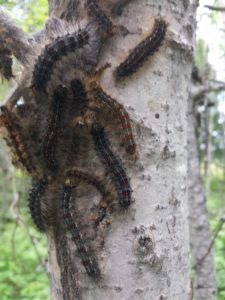An isolated outbreak of gypsy moth was documented on private property in southeastern Burnett County in July. The origin of this population was most likely unintentional movement of outdoor items (e.g., R.V. campers) infested with gypsy moth life stages (e.g., egg masses) from an area where gypsy moth is established. The severity of gypsy moth defoliation ranged from light to heavy across the 60 acre mixed species woodland. Aspen was the most heavily defoliated species, with a 7 acre block of 15 year old aspen sustaining over 75% defoliation. Surprisingly, adult gypsy moths were already flying, and younger caterpillars were still feeding. This was several weeks earlier in the season than normal moth flight would be expected in the state’s north, possibly owing to strong competition between caterpillars within this high population. Burnett County is currently not quarantined for a gypsy moth and the pest is not considered established there.

Gypsy moth caterpillars (Photo by Paul Cigan)
The Slow the Spread program is considering an aerial spray treatment of this property next year to control the population. This isolated outbreak, several counties west of the contiguous quarantined area, provides a good reminder of the important role of human-assisted spread of gypsy moth to new areas – and a reminder of the opportunities to prevent such introductions. Landowners and forestry professionals can help prevent gypsy moth spread by inspecting and cleaning outdoor items when traveling from quarantined to non-quarantined counties, keeping firewood local, and by following other gypsy moth quarantine regulations and reasonable precautions. More information about gypsy moth can be found at gypsymoth.wi.gov.
Written by Paul Cigan, forest health specialist, Hayward (Paul.Cigan@Wisconsin.gov), 715-416-4920.
